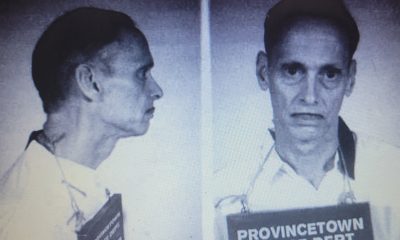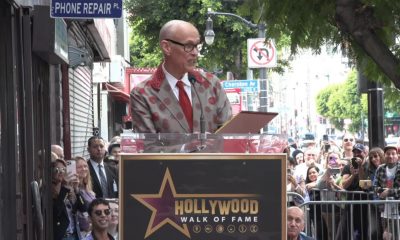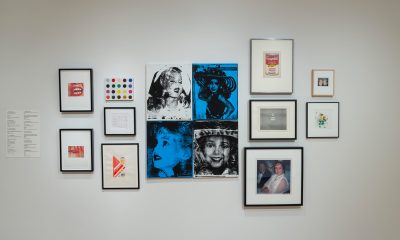a&e features
Actress tells all in ‘Mommie’ memoir
Carol Ann on the shoot from hell and what she’d say to Faye Dunaway today
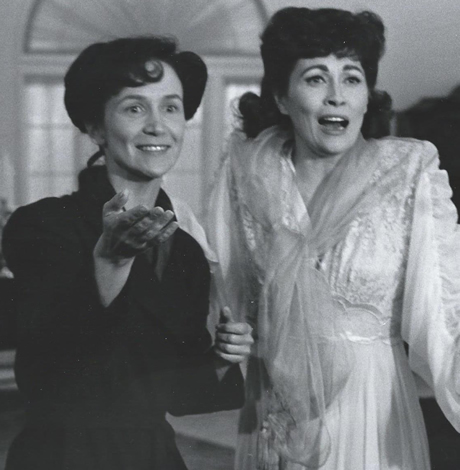
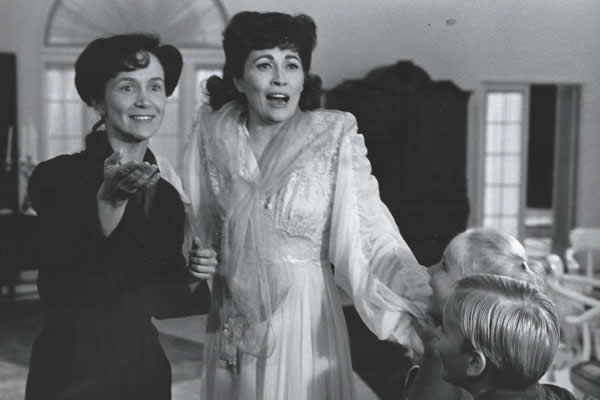
Rutanya Alda, left, with Faye Dunaway, Mara Hobel and Jeremy Scott Reinholt in ‘Mommie Dearest.’ (Photo courtesy Alda)
Editor’s note: this is part two of two of our interview with actress Rutanya Alda, author of”The Mommie Dearest Diary: Carol Ann Tells All.” Part one is here.
WASHINGTON BLADE: Although you don’t hold back at all in your book concerning working with Faye Dunaway, your “Mommie Dearest” co-star, it didn’t feel to me that you had an axe to grind. You write of several moments too where she was gracious — signing photos, posing for photos on set with your brother, when you give her the sweater you made and so on. On the other hand, the book “Mommie Dearest” always felt to me like Christina had a huge axe to grind. Do you agree?
RUTANYA ALDA: I tried to be fair in my book and I hope when Faye reads it she can respect the fact that I was fair to her. … It’s very hard to be with a person on the set who is totally ungiving to the other actor. I just held my tongue then because, as you know from the book, she never stayed for any of my close-ups. I stayed for hers to the 12th, the 13th hour and she never turned around and stayed for any of mine. It’s really not honoring the other actor and we have to honor that. We’re a team working together for the best of the scene. I always felt Faye worked for herself only and that’s the truth. There were private moments when I felt really bad for her … but those moments really didn’t last that long. It’s too bad because, you know honestly, if she had just been gracious (to the crew), they would have embraced her but instead she alienated so many people. When my brother was there as a guest and talked to her, I just got her at a good moment. If it had been a volatile moment, I wouldn’t have dared ask her. The timing just happened to have been right and she was as mellow as she could get. But we were always on pins and needles and you just knew you didn’t want to ask certain things at certain times.
BLADE: Hollywood lore is so full of stories of bitchy star behavior. In your experience, is there always fire where there’s smoke or does some of this get unfairly exaggerated in the public’s endless appetite for such tales?
ALDA: It’s gotten to be so much about me, me, me that some people think the whole world rotates around them and that’s really the worst position for an actor to put themselves in. As Bette Davis said, you’ll meet the same people on your way down as your way up. Fame is fleeting. It lasts for a while. If you have a few years’ run or a decade run, you’re lucky and I think if you can be compassionate and kind, I think that’s a great lesson to give people. I just went to a luncheon at 21 and the coat check girl, so many fairly well known people just throw their coat down and go upstairs and you know, it only takes a second or two to say, “Thank you,” and smile. She remembered me from the time before … just because I treated her like a human being. A lot of stars have come up very quickly and without the experience of being in the industry very long and I think they don’t appreciate the audience as much as they should. A smile or a hello is all you need to give sometimes. Without the audience, you have nothing. …
And the audience of “Mommie Dearest” is a great audience and I think they are disappointed that Faye has never embraced the film. If I were Faye Dunaway, I would have said, “Look, I was great in the part, I did great things. OK, maybe I had an over-the-top performance, but it worked, didn’t it?” But all these years of not talking about it and suddenly after 30 years she’s writing a book? Why? What’s in it for her? Is she doing it for the money? She’s really deprived herself of a great audience of people who love the movie and it’s a detriment to her. Look at all the joy she missed.
BLADE: So you know she is proceeding with her own book?
ALDA: Yes, she has a contract with a publishing house. A friend I know, whom I won’t name unless he names himself, he was just offered to be her ghostwriter. I think she’s gone through several. I e-mailed him and said, “Are you going to do it?” He said, “No, not even if she gives me a million dollars cash would I put myself through this.” So she’s going to find someone from whatever point of view she’s going to do it and I think it’s supposed to be out sometime next year. When she wrote to me, it said time sensitive, she in other words, she probably has a date by which she has to turn it in. Usually it’s a year and a half, then you’re supposed to deliver the book.
BLADE: On his “Mommie Dearest” commentary, John Waters said he thought the film would have worked as straight drama with just some slightly more judicious editing, for instance the scene where you see Diana’s (Scarwid as Christina) panties. Do you agree?
ALDA: (laughs) No. Don’t get me wrong, I love John Waters, I think he’s wonderful, but no, I don’t agree with that. I just ran into an editor who was working on another movie at Paramount at the time and he’d read the script, he’s gay, and he really wanted to edit the film. He loved it and saw it as a camp movie right away and said to Frank, “I want to edit it.” Frank said, “No, you’re the wrong person, we want this to be a big drama,” and I thought, “My gosh, I never knew this.” He said, “You didn’t know it was camp when you read the script?” I said, “No.” He knew right away. But you know, they edited like an hour and a half out of that movie anyway. Some of the takes were really, really long and so much was cut, especially my scenes. I don’t know if it would have changed it but I think it would have made more sense if some of it had been put back, like when my character, Carol Ann, meets Joan and is hired by Joan. I think that would have been a good addition to the story. … But I’m kind of glad the way it turned out because it’s going to continue to have this huge following for years. If it had just been a straight drama, I don’t think we’d be talking today. I think it would have just been one of these movies that was a good movie and then people would have forgotten about it. It’s given people a lot of joy through the years.
BLADE: Do you think “Mommie Dearest” ruined Faye’s career? I know that’s probably an oversimplification, but people say that and it does seem like her filmography is quite spotty after that.
ALDA: I don’t think so. She did quite a few films after it, maybe 10 or 15.
BLADE: Yes, but there was never another “Network” or “Chinatown”-caliber film after it.
ALDA: No, because what did she choose right after “Mommie Dearest”? “Supergirl”? I mean, her choice of material — she still had the power to choose her own material at that point and she was choosing stuff that wasn’t in the same league as “Network,” or, you know, “Chinatown.” I mean these are really great films, really amazing films, and she chooses “Supergirl” and other films you can’t even remember? Even the movie she likes to talk about with Marlon Brando and Johnny Depp (“Don Juan DeMarco”), well that’s not a very good movie. I mean God bless all the actors, but some movies just don’t work. Her choice of parts was really not good. Also I think when one is constantly late on a set and constantly causes production to be slowed down, sooner or later producers just don’t want to lose that money. We went a couple of million dollars over budget because of constant lateness and finally Frank Yablans pulled the plug and we just weren’t going to shoot anymore, that was it. I think today producers won’t put up with that. Show up on time. OK, once in a while, you’re five-10 minutes late, you can’t help it, but not five and six hours late. There’s too much money involved today.
BLADE: “Mommie Dearest” lives on as a camp classic and nobody takes it — at least the film — seriously. Has Joan had the last laugh?
ALDA: Oh, absolutely. Joan Crawford’s career got resurrected. All of a sudden it’s her films that are seen and viewed and she’s kind of the big star here instead of Faye. People are seeing her films. At the Film Forum downtown, there’s a retrospective of her movies next weekend and it’s just amazing. People are rediscovering her that have never seen her movies. I think Joan Crawford has become the big star instead of Faye.
BLADE: Was Joan a good actress?
ALDA: I think she was a wonderful actress for that era. She was over the top and mannered, but that was the movies of that era. I think she was marvelous in those kinds of movies. People don’t act that way today, but they’re fascinating to watch. You look at “Mildred Pierce” and “Baby Jane” and even some of the horror movies she did and she was really pretty impressive. I just saw “Baby Jane” again not long ago and I thought she and Bette were really over the top, but it works. What two actresses today could do that style in that kind of way and make it so memorable and unique? There’s nobody like them.
BLADE: Joan mistook you for Mia Farrow when you were her stand-in on “Rosemary’s Baby” where she was to have had a cameo. Did she say anything after she realized you weren’t Mia?
ALDA: No, she was just very charming. She didn’t come over and say anything afterward but I didn’t go over to her either. She was just standing there, very gracious, and there was something about her that just radiated star. She had been a star for 50 years and she knew who she was.
BLADE: But she didn’t brush you off or anything?
ALDA: No, not at all.
BLADE: You write at length about what a great actor your husband Richard Bright was and it seems like he kind of got swallowed up by the machine, so to speak, with his drug issues. With true persistence and talent, does the cream always rise in Hollywood or have you seen truly talented people fall through the cracks?
ALDA: Unfortunately I don’t think the cream always rises. When I started out 50 years ago, I knew a lot of really, really talented people, much more talented than the people that eventually became stars, I thought, so no. But it’s very difficult because a lot of really talented people are also so sensitive and their sensitivity winds up destroying them. In Richard’s case, he was a wonderful actor, really terrific, as Al Pacino acknowledges. He used to watch Richard work. (Richard was) pained by not working and that’s what really drove him to drugs — the pain from not working and expressing himself. I think so much of it is just luck. I’ve known a lot of people who do it for 10-15 years and they just emotionally can’t take it anymore, the rejection. It’s just such a crapshoot and you don’t know what direction your life takes you. … Look at someone like Phillip Seymour Hoffman. … As painful as that was, I think that opened a little more compassion in people because he was one who did achieve a lot of success. … It’s a very, very difficult business. People shove their kids in front of me and ask for advice for this teenage girl who wants to be an actress. I always say don’t do it if you have any other choice of a career. It’s gotta be in your blood so deep that you can’t do anything else. … Enjoy your life. Life is short. Being an actor is like having a virus you can’t get rid of.
BLADE: Do you wish you had left Richard sooner?
ALDA: Well I loved my husband a lot. … He was a good person, a very generous person. I just had no idea what his addiction meant and that it was so hard to break that chain. I didn’t understand that you can’t do it for them. …. This was the ‘80s and there was a lot then we didn’t fully understand. I think later when the Betty Fords and other programs, there was more understanding, but this was the early ‘80s.
BLADE: Do you think Christina wrote her book just to get back at Joan for being left out of the will?
ALDA: No, because I think the book was already more or less written before Joan died. Now, did Joan leave her out of the will because she knew she was writing a book? I don’t know, maybe. But the book was done before the will. Had it been the other way around, I might have said yeah. It was a scandalous thing to do at the time because she was the first to do it, the first to write and sort of reveal her life with a major star. Later one of the Crosby kids wrote about Bing Crosby and Bette Davis’s daughter wrote about Bette Davis, but she was the first.
BLADE: Had you read the book when it came out or did you read it when you got the part?
ALDA: I read it when I was getting ready for the film, I’d heard about but didn’t read it until I was cast.
BLADE: Why did Christina never visit the set? I would have thought she’d have been at least curious.
ALDA: She told me the script was totally different and she just wanted to let it go. She and her husband, David Koontz, had written a script that was rejected so after Frank and Frank took over, she just felt she’d sold the rights, it was going to be what it was going to be and it was out of her hands so she had not interest in visiting the set.
BLADE: Why did you choose the self-publishing route for your book?
ALDA: I’d had it with an agent for almost two years and I just felt he wasn’t getting it out to the right people. I could have tried to find another agent but I thought, OK, that could be another two years. I learned things happen rather slowly in the publishing world, at least from my experience, and I felt this was the right time to put it out. Actually Christina Crawford was one person who encouraged me to self publish because she had done it after “Mommie Dearest.” … I thought, well, at least that way we’ll get it out into the world and I won’t be waiting and waiting and waiting. I’m glad I did it because at least I beat Faye.
BLADE: You write of how painful the makeup was on the film. How long did it take your face to fully heal after the film?
ALDA: About a month. Things are better with appliances now, but at the time with all that glue on your skin, it was really sore and red and tender.
BLADE: You said you knew of the film’s camp element immediately upon seeing it, but did you realize the gay element in that then too or did that come later?
ALDA: I didn’t really know that then, no. I think my first inkling to that was when I did the Town Hall show Mother’s Day with Joan about 10 years ago with Lypsinka, who is absolutely brilliant. Then, of course, about three years ago there was a show with Hedda Lettuce. She said, “Do you have any stories from ‘Mommie Dearest,’” and I said, “Yeah, I kept a journal.” She said, “Could you come read something from it,” so I went and read a few things. Then Marc Huestis called me two years ago and asked me to come to the Castro to read from it. I said, “Do you think anybody would be interested?” He said yes, so then at the Castor there were like 1,500 beautiful gay men and honestly just this wave of love that hit me and, wow, I still feel it in my heart, this love and support that came from the audience. I’m very emotional about it still. I read from my diary and they just went wild, they were so wonderful. So they were the first real audience and I thought, oh my God, I’ve got to publish this book. It hit me that people were really interested.
BLADE: Did you read Faye’s autobiography “Looking for Gatsby”?
ALDA: No. I went to Barnes & Noble to look at it. I thumbed through it but there didn’t seem to be much on “Mommie Dearest” so I didn’t buy it.
BLADE: What would you say if you were in an elevator with her?
ALDA: Hi. But she might not answer me because there were a lot of times on the set when she’d just walk right by. I’d be prepared for that.
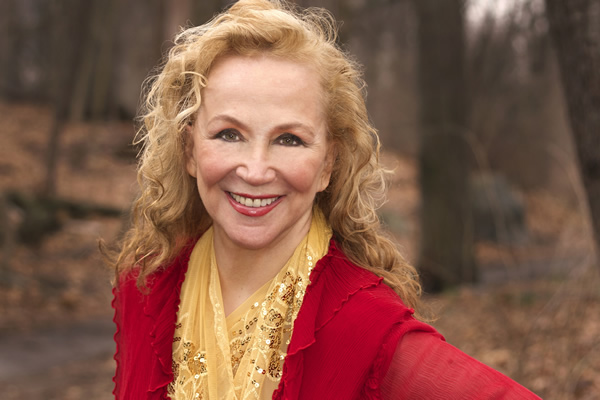
Rutanya Alda today. (Photo courtesy Alda)
a&e features
What to expect at the 2024 National Cannabis Festival
Wu-Tang Clan to perform; policy discussions also planned
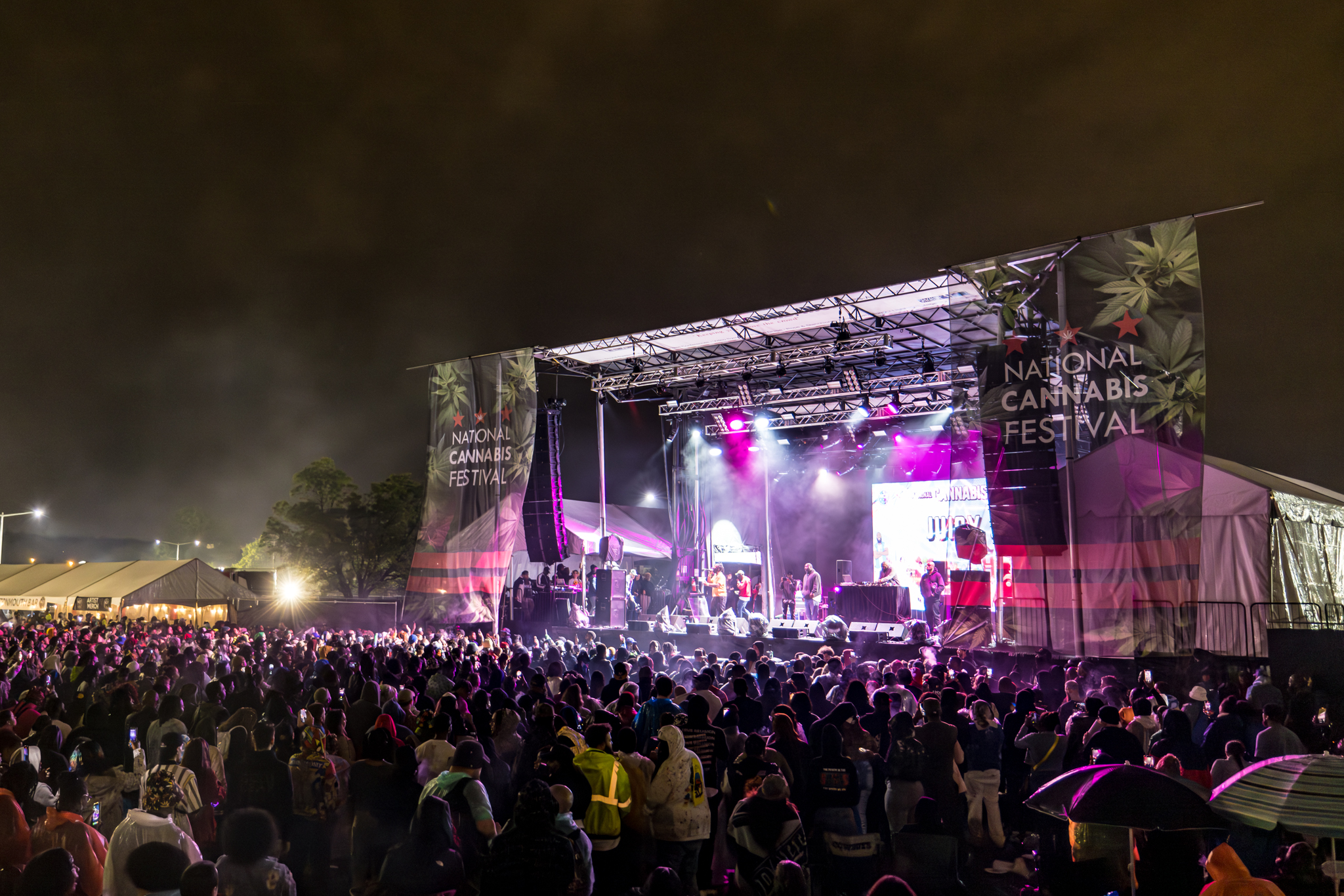
(Editor’s note: Tickets are still available for the National Cannabis Festival, with prices starting at $55 for one-day general admission on Friday through $190 for a two-day pass with early-entry access. The Washington Blade, one of the event’s sponsors, will host a LGBTQIA+ Lounge and moderate a panel discussion on Saturday with the Mayor’s Office of LGBTQ Affairs.)
With two full days of events and programs along with performances by Wu-Tang Clan, Redman, and Thundercat, the 2024 National Cannabis Festival will be bigger than ever this year.
Leading up to the festivities on Friday and Saturday at Washington, D.C.’s RFK Stadium are plenty of can’t-miss experiences planned for 420 Week, including the National Cannabis Policy Summit and an LGBTQ happy hour hosted by the District’s Black-owned queer bar, Thurst Lounge (both happening on Wednesday).
On Tuesday, the Blade caught up with NCF Founder and Executive Producer Caroline Phillips, principal at The High Street PR & Events, for a discussion about the event’s history and the pivotal political moment for cannabis legalization and drug policy reform both locally and nationally. Phillips also shared her thoughts about the role of LGBTQ activists in these movements and the through-line connecting issues of freedom and bodily autonomy.
After D.C. residents voted to approve Initiative 71 in the fall of 2014, she said, adults were permitted to share cannabis and grow the plant at home, while possession was decriminalized with the hope and expectation that fewer people would be incarcerated.
“When that happened, there was also an influx of really high-priced conferences that promised to connect people to big business opportunities so they could make millions in what they were calling the ‘green rush,'” Phillips said.
“At the time, I was working for Human Rights First,” a nonprofit that was, and is, engaged in “a lot of issues to do with world refugees and immigration in the United States” — so, “it was really interesting to me to see the overlap between drug policy reform and some of these other issues that I was working on,” Phillips said.
“And then it rubbed me a little bit the wrong way to hear about the ‘green rush’ before we’d heard about criminal justice reform around cannabis and before we’d heard about people being let out of jail for cannabis offenses.”
“As my interests grew, I realized that there was really a need for this conversation to happen in a larger way that allowed the larger community, the broader community, to learn about not just cannabis legalization, but to understand how it connects to our criminal justice system, to understand how it can really stimulate and benefit our economy, and to understand how it can become a wellness tool for so many people,” Phillips said.
“On top of all of that, as a minority in the cannabis space, it was important to me that this event and my work in the cannabis industry really amplified how we could create space for Black and Brown people to be stakeholders in this economy in a meaningful way.”
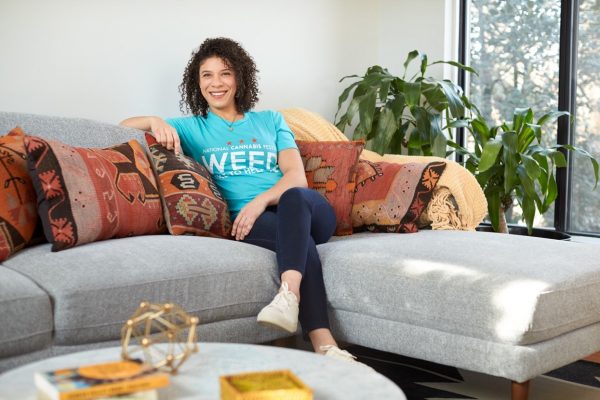
“Since I was already working in event production, I decided to use those skills and apply them to creating a cannabis event,” she said. “And in order to create an event that I thought could really give back to our community with ticket prices low enough for people to actually be able to attend, I thought a large-scale event would be good — and thus was born the cannabis festival.”
D.C. to see more regulated cannabis businesses ‘very soon’
Phillips said she believes decriminalization in D.C. has decreased the number of cannabis-related arrests in the city, but she noted arrests have, nevertheless, continued to disproportionately impact Black and Brown people.
“We’re at a really interesting crossroads for our city and for our cannabis community,” she said. In the eight years since Initiative 71 was passed, “We’ve had our licensed regulated cannabis dispensaries and cultivators who’ve been existing in a very red tape-heavy environment, a very tax heavy environment, and then we have the unregulated cannabis cultivators and cannabis dispensaries in the city” who operate via a “loophole” in the law “that allows the sharing of cannabis between adults who are over the age of 21.”
Many of the purveyors in the latter group, Phillips said, “are looking at trying to get into the legal space; so they’re trying to become regulated businesses in Washington, D.C.”
She noted the city will be “releasing 30 or so licenses in the next couple of weeks, and those stores should be coming online very soon” which will mean “you’ll be seeing a lot more of the regulated stores popping up in neighborhoods and hopefully a lot more opportunity for folks that are interested in leaving the unregulated space to be able to join the regulated marketplace.”
National push for de-scheduling cannabis
Signaling the political momentum for reforming cannabis and criminal justice laws, Wednesday’s Policy Summit will feature U.S. Sens. Raphael Warnock (D-Ga.), Jeff Merkley (D-Ore.), Elizabeth Warren (D-Mass.), and Chuck Schumer (D-N.Y.), the Senate majority leader.
Also representing Capitol Hill at the Summit will be U.S. Congresswoman Eleanor Holmes Norton (D-D.C.) and U.S. Reps. Earl Blumenauer (D-Ore.) and Barbara Lee (D-Calif.) — who will be receiving the Supernova Women Cannabis Champion Lifetime Achievement Award — along with an aide to U.S. Rep. David Joyce (R-Ohio).
Nationally, Phillips said much of the conversation around cannabis concerns de-scheduling. Even though 40 states and D.C. have legalized the drug for recreational and/or medical use, marijuana has been classified as a Schedule I substance since the Controlled Substances Act was passed in 1971, which means it carries the heftiest restrictions on, and penalties for, its possession, sale, distribution, and cultivation.
The U.S. Department of Health and Human Services formally requested the drug be reclassified as a Schedule III substance in August, which inaugurated an ongoing review, and in January a group of 12 Senate Democrats sent a letter to the Biden-Harris administration’s Drug Enforcement Administration urging the agency to de-schedule cannabis altogether.
Along with the Summit, Phillips noted that “a large contingent of advocates will be coming to Washington, D.C. this week to host a vigil at the White House and to be at the festival educating people” about these issues. She said NCF is working with the 420 Unity Coalition to push Congress and the Biden-Harris administration to “move straight to de-scheduling cannabis.”
“This would allow folks who have been locked up for cannabis offenses the chance to be released,” she said. “It would also allow medical patients greater access. It would also allow business owners the chance to exist without the specter of the federal government coming in and telling them what they’re doing is wrong and that they’re criminals.”
Phillips added, however, that de-scheduling cannabis will not “suddenly erase” the “generations and generations of systemic racism” in America’s financial institutions, business marketplace, and criminal justice system, nor the consequences that has wrought on Black and Brown communities.
An example of the work that remains, she said, is making sure “that all people are treated fairly by financial institutions so that they can get the funding for their businesses” to, hopefully, create not just another industry, but “really a better industry” that from the outset is focused on “equity” and “access.”
Policy wonks should be sure to visit the festival, too. “We have a really terrific lineup in our policy pavilion,” Phillips said. “A lot of our heavy hitters from our advocacy committee will be presenting programming.”
“On Saturday there is a really strong federal marijuana reform panel that is being led by Maritza Perez Medina from the Drug Policy Alliance,” she said. “So that’s going to be a terrific discussion” that will also feature “representation from the Veterans Cannabis Coalition.”
“We also have a really interesting talk being led by the Law Enforcement Action Partnership about conservatives, cops, and cannabis,” Phillips added.
Cannabis and the LGBTQ community
“I think what’s so interesting about LGBTQIA+ culture and the cannabis community are the parallels that we’ve seen in the movements towards legalization,” Phillips said.
The fight for LGBTQ rights over the years has often involved centering personal stories and personal experiences, she said. “And that really, I think, began to resonate, the more that we talked about it openly in society; the more it was something that we started to see on television; the more it became a topic in youth development and making sure that we’re raising healthy children.”
Likewise, Phillips said, “we’ve seen cannabis become more of a conversation in mainstream culture. We’ve heard the stories of people who’ve had veterans in their families that have used cannabis instead of pharmaceuticals, the friends or family members who’ve had cancer that have turned to CBD or THC so they could sleep, so they could eat so they could get some level of relief.”
Stories about cannabis have also included accounts of folks who were “arrested when they were young” or “the family member who’s still locked up,” she said, just as stories about LGBTQ people have often involved unjust and unnecessary suffering.
Not only are there similarities in the socio-political struggles, Phillips said, but LGBTQ people have played a central role pushing for cannabis legalization and, in fact, in ushering in the movement by “advocating for HIV patients in California to be able to access cannabis’s medicine.”
As a result of the queer community’s involvement, she said, “the foundation of cannabis legalization is truly patient access and criminal justice reform.”
“LGBTQIA+ advocates and cannabis advocates have managed to rein in support of the majority of Americans for the issues that they find important,” Phillips said, even if, unfortunately, other movements for bodily autonomy like those concerning issues of reproductive justice “don’t see that same support.”
a&e features
Juliet Hawkins’s music defies conventional categorization
‘Keep an open mind, an open heart, and a willingness to evolve’
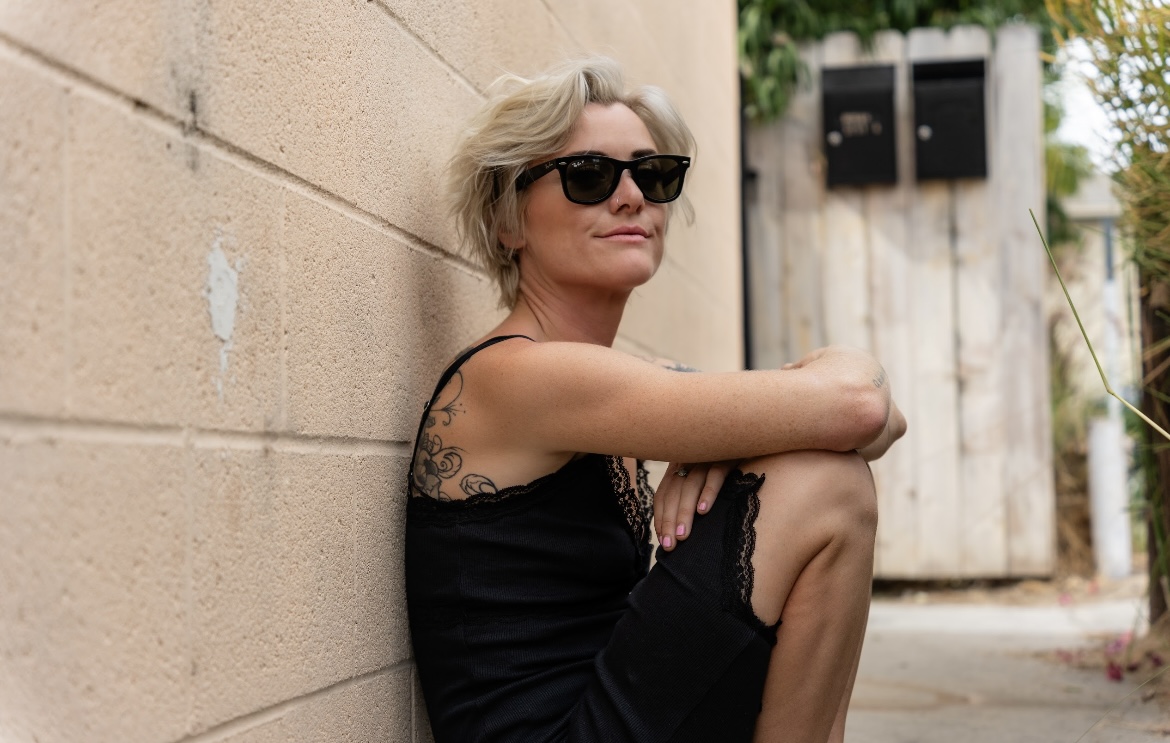
LONG BEACH, Calif. – Emerging from the dynamic music scene of Los Angeles, Juliet Hawkins seamlessly integrates deeply soulful vocals with contemporary production techniques, crafting a distinctive sound that defies conventional categorization.
Drawing inspiration from the emotive depth of Amy Winehouse and weaving together elements of country, blues, and pop, Hawkins’ music can best be described as a fusion–perhaps best termed as soulful electronica. Yet, even this characterization falls short, as Hawkins defines herself as “a blend of a million different inspirations.”
Hawkins’s musical palette mirrors her personae: versatile and eclectic. Any conversation with Hawkins makes this point abundantly clear. She exhibits the archetype of a wild, musical genius while remaining true to her nature-loving, creative spirit. Whether recording in the studio for an album release, performing live in a studio setting, or playing in front of a live audience, Hawkins delivers her music with natural grace.
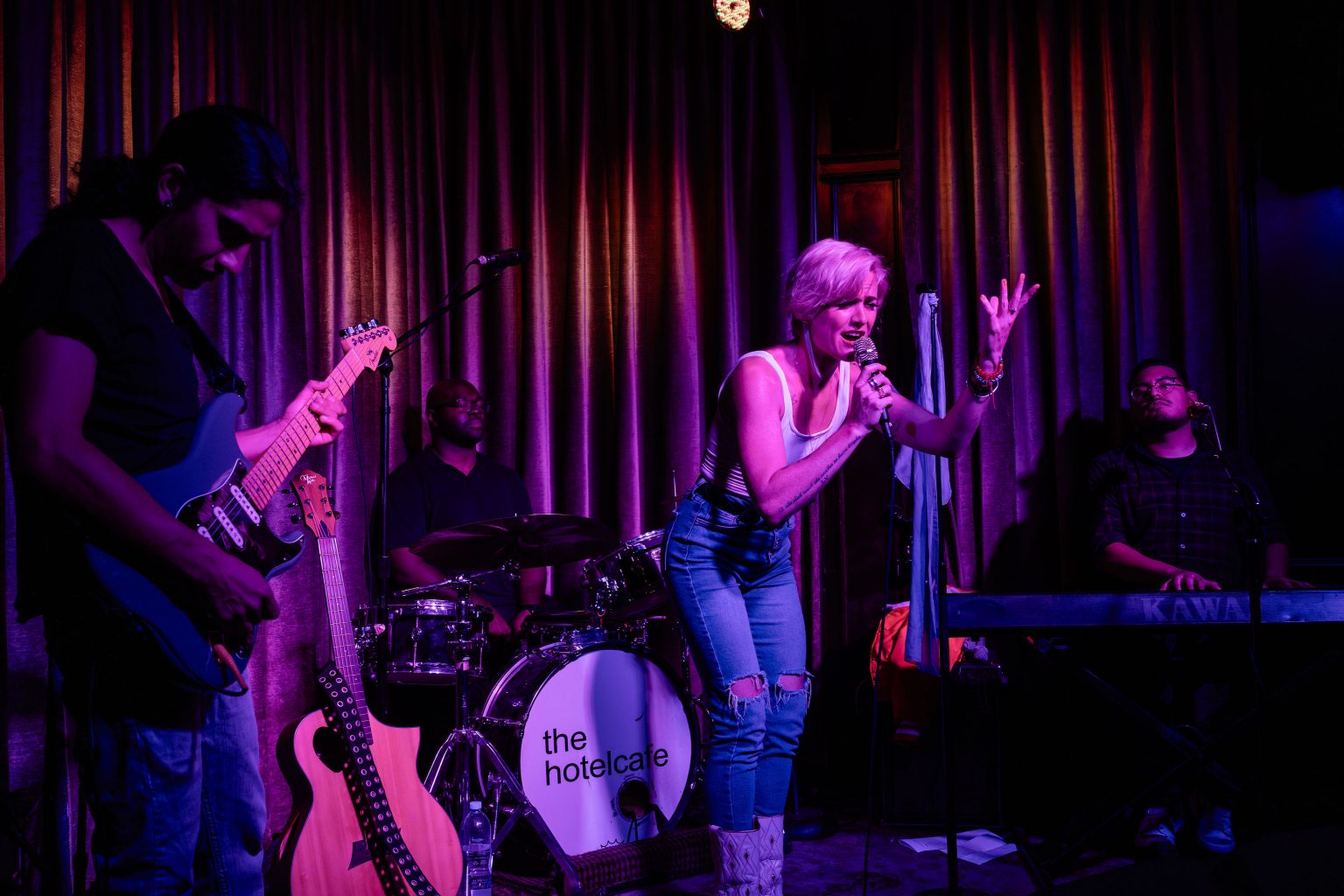
However, Hawkins’s musical journey is far from effortless. Amid personal challenges and adversity, she weaves her personal odyssey of pain and pleasure, transforming these experiences into empowering anthems.
In a candid interview with the Blade, Hawkins spoke with profound openness and vulnerability about her past struggles with opiate and heroin addiction: “That was 10 years ago that I struggled with opiates,” she shared. Yet, instead of letting her previous addiction define her, Hawkins expressed to the Blade that she harbors no shame about her past. “My newer music is much more about empowerment than recovery,” she explained, emphasizing that “writing was the best way to process trauma.”
Despite her struggles with addiction, Hawkins managed to recover. However, she emphasizes that this recovery is deeply intertwined with her spiritual connection to nature. An illustrative instance of Hawkins’ engagement with nature occurred during the COVID pandemic.
Following an impulse that many of us have entertained, she bought a van and chose to live amidst the trees. It was during this period that Hawkins composed the music for her second EP, titled “Lead with Love.”
In many ways, Hawkins deep spiritual connection to nature has been profoundly shaped by her extensive travels. Born in San Diego, spending her formative years in Massachusetts, and later moving to Tennessee before returning to Southern California, she has broadened her interests and exposed herself to the diverse musical landscapes across America.
“Music is the only thing I have left,” Hawkins confides to the Blade, highlighting the integral role that music has in her life. This intimate relationship with music is evident in her sultry and dynamic compositions. Rather than imitating or copying other artists, Hawkins effortlessly integrates sounds from some of her favorite musical influences to create something new. Some of these influences include LP, Lucinda Williams, Lana Del Rey, and, of course, Amy Winehouse, among others.
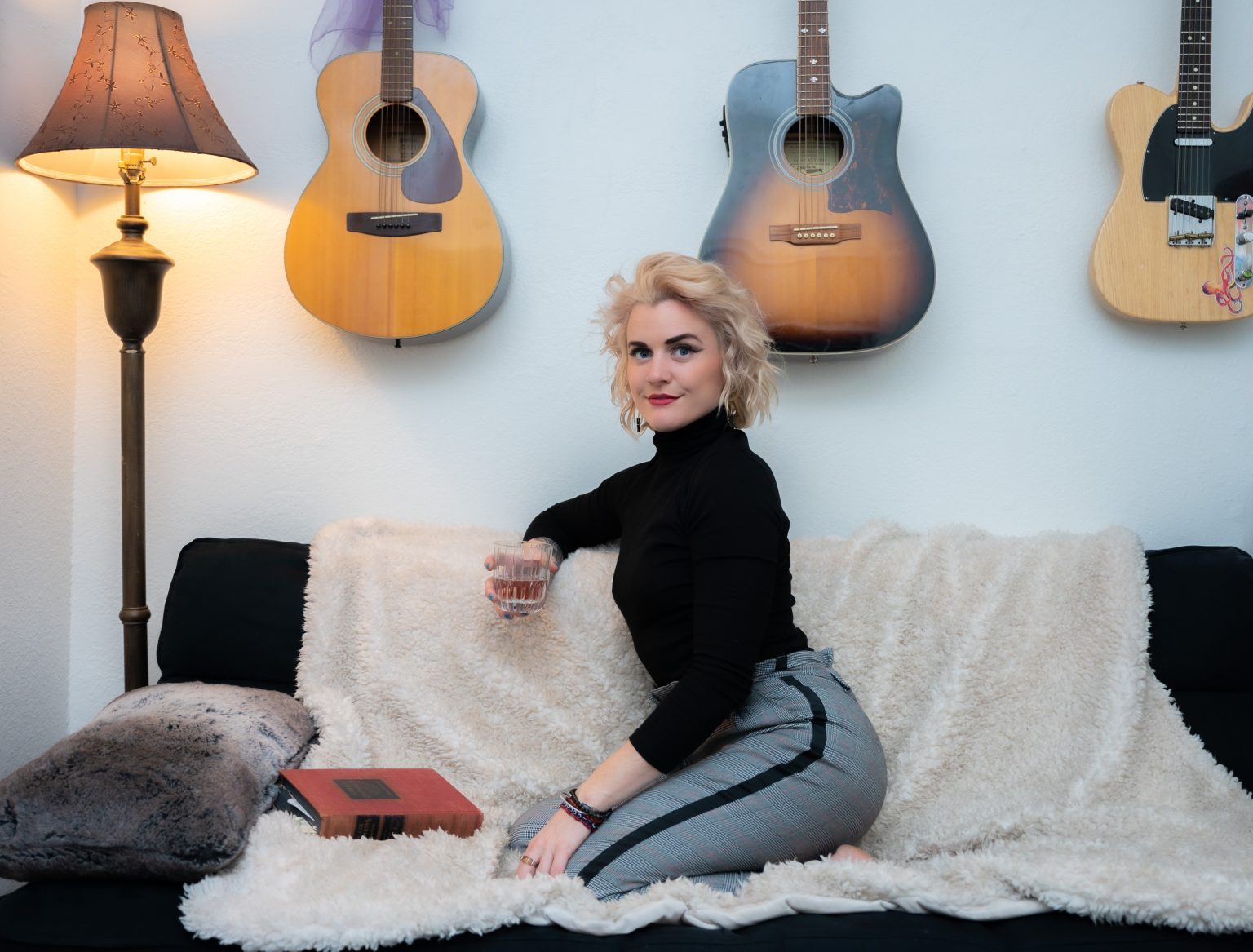
Hawkins has always been passionate about music—-she began with piano at a young age, progressed to guitar, and then to bass, eagerly exploring any instrument she could get her hands on. However, instead of following a traditional path of formalized lessons and structured music theory, Hawkins told the Blade that she “has a hard time following directions and being told what to do.”
This independent approach has led her to experiment with various genres and even join unexpected groups, such as a tribute band for Eric Clapton and Cream. While she acknowledges that her eclectic musical interests might be attributed to ADHD, she holds a different belief: “Creative minds like to move around.”
When discussing her latest musical release — “Stay True (the live album)” which was recorded in a live studio setting — Hawkins describes the experience as a form of improvisation with both herself and the band:
“[The experience] was this divine honey that was flowing through all of us.” She explains that this live album was uncertain in the music’s direction. “For a couple of songs,” Hawkins recalls, “we intuitively closed them out.” By embracing creative spontaneity and refusing to be constrained by fear of mistakes, the live album authentically captures raw sound, complete with background chatter, extended outros, and an extremely somber cover of Ozzy Osbourne’s “Crazy Train” coupled with a slow piano and accompanied strings.
While “Stay True” was a rewarding experience for Hawkins, her favorite live performance took place in an unexpected location—an unattended piano in the middle of an airport. As she began playing Beethoven’s “Moonlight Sonata”, Hawkins shared with the Blade a universal connection we all share with music: “This little girl was dancing as I was playing.”
After the performance, tears welled in Hawkins’ eyes as she was touched by the young girl’s appreciation of her musicianship. Hawkins tells the Blade, “It’s not about playing to an audience—it’s about finding your people.”
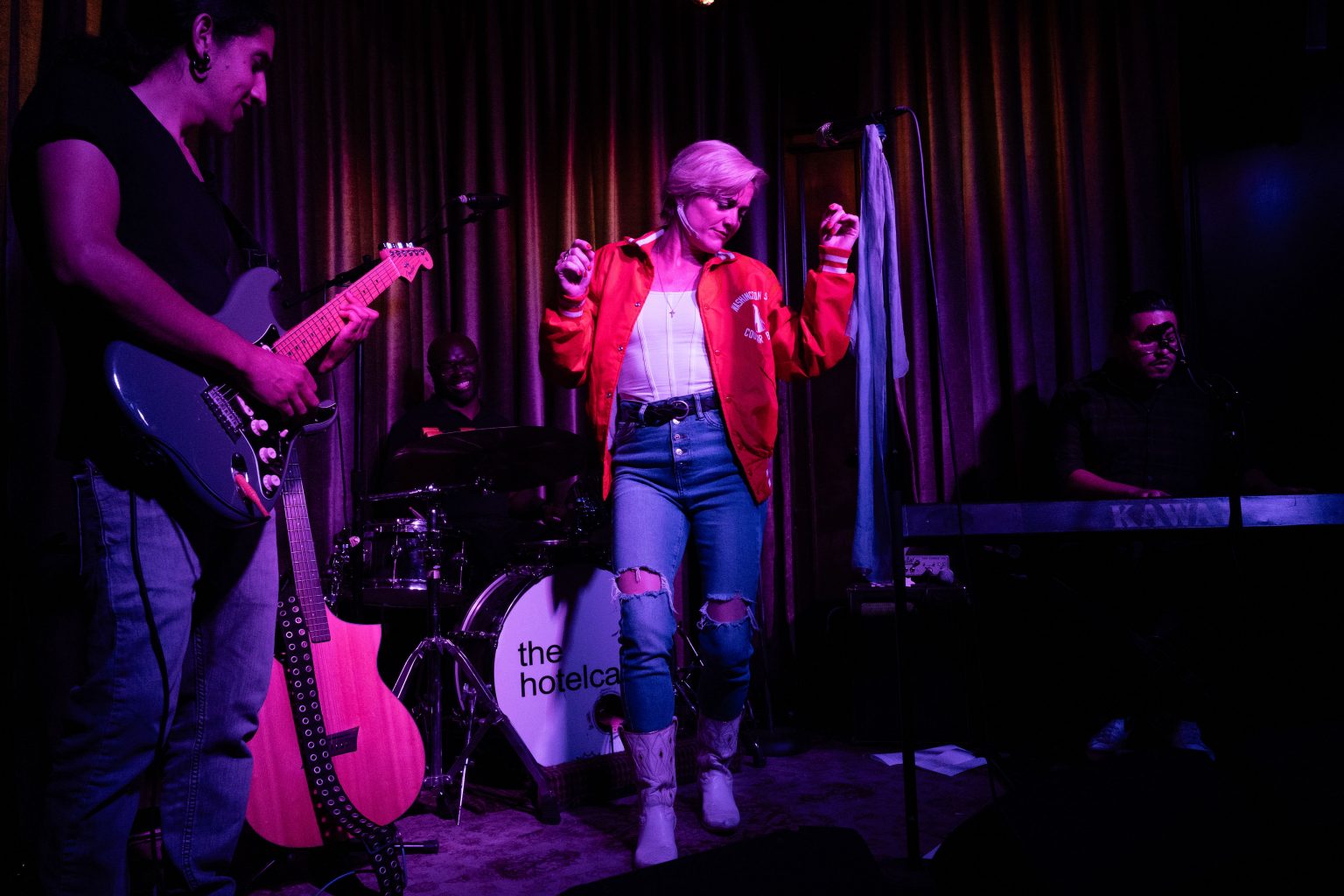
What sets Hawkins apart as an artist is her ability to connect with her audience in diverse settings. She highlights EDC, an electronic dance music festival, as a place where she unabashedly lets her “freak flag” fly and a place to connect with her people. Her affinity for electronic music not only fuels her original pop music creations, but also inspires her to reinterpret songs with an electronic twist. A prime example of this is with her electronic-style cover of Tal Bachman’s 90’s hit, “She’s So High.”
As an openly queer woman in the music industry, Hawkins is on a mission to safeguard artistic integrity. In songs like “My Father’s Men,” she bares her vulnerability and highlights the industry’s misogyny, which often marginalizes gender minorities in their pursuit of artistic expression.
She confides to the Blade, “The industry can be so sexist, misogynist, and oppressive,” and points out that “there are predators in the industry.” Yet, rather than succumbing to apathy, Hawkins is committed to advocating for gender minorities within the music industry.
“Luckily, people are rising up against misogyny, but it’s still there. ‘My Father’s Men’ is a message: It’s time for more people who aren’t just white straight men to have a say.”
Hawkins is also an activist for other causes, with a fervent belief in the preservation of bodily autonomy. Her self-directed music video “I’ll play Daddy,” showcases the joy of embracing one’s body with Hawkins being sensually touched by a plethora of hands. While the song, according to Hawkins, “fell upon deaf ears in the south,” it hasn’t stopped Hawkins from continuing to fight for the causes she believes in. In her interview, Hawkins encapsulated her political stance by quoting an artist she admires:
“To quote Pink, ‘I don’t care about your politics, I care about your kids.’”
When Hawkins isn’t writing music or being a champion for various causes, you might catch her doing the following: camping, rollerblading, painting, teaching music lessons, relaxing with Bernie (her beloved dog), stripping down for artsy photoshoots, or embarking on a quest to find the world’s best hollandaise sauce.
But at the end of the day, Hawkins sums up her main purpose: “To come together with like-minded people and create.”
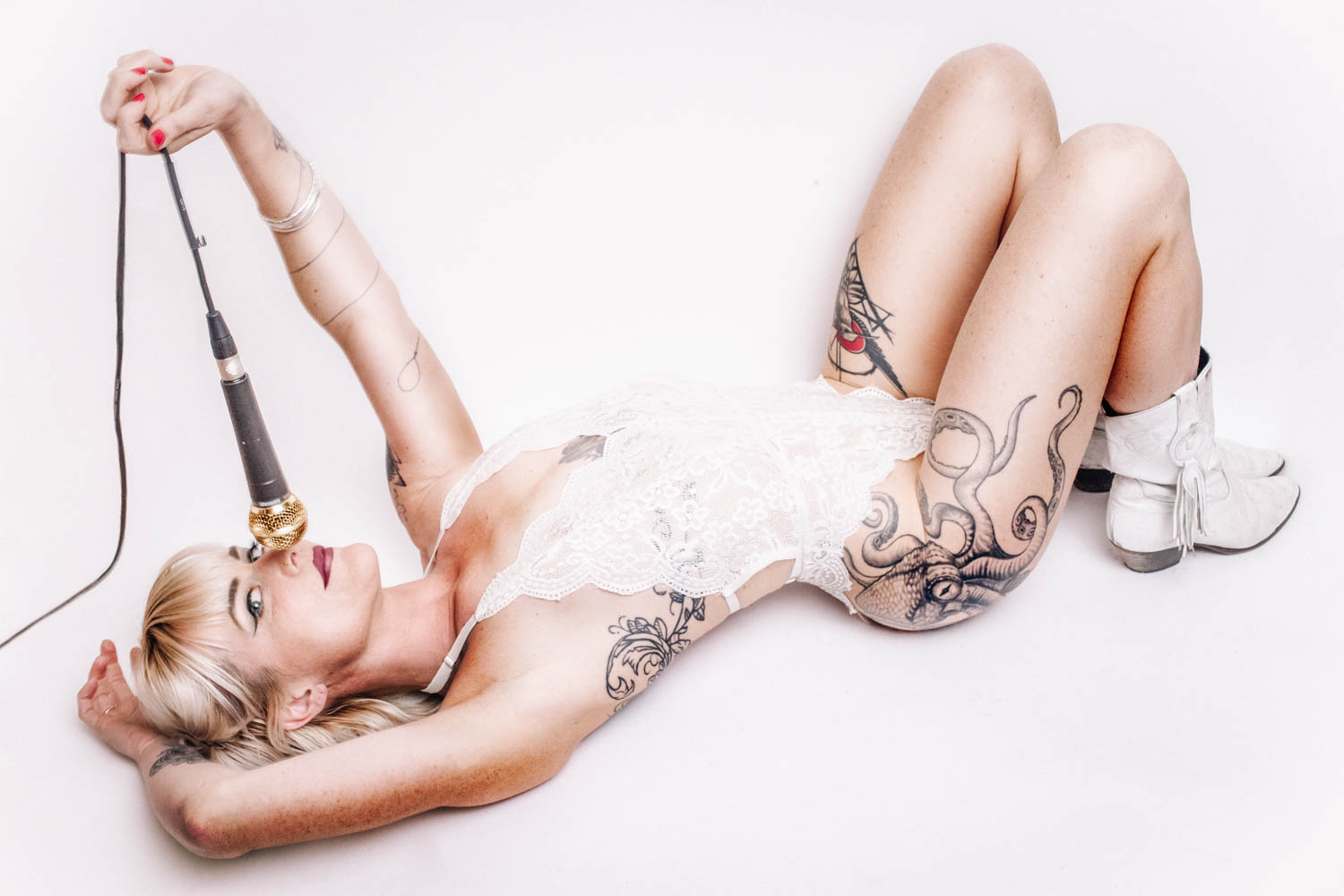
Part of this ever-evolving, coming-of-age-like journey includes an important element: plant-based medicine. Hawkins tells the Blade that she acknowledges her previous experience with addiction and finds certain plants to be useful in her recovery:
“The recovery thing is tricky,” Hawkins explains, “I don’t use opiates—-no powders and no pills—but I am a fan of weed, and I think psilocybin can be helpful when used at the right time.” She emphasizes the role of psychedelics in guiding her towards her purpose. “Thanks for psychedelics, I have a reignited sense of purpose … Music came naturally to me as an outlet to heal.”
While she views the occasional dabbling of psychedelics as a spiritual practice, Hawkins also embraces other rituals, particularly those she performs before and during live shows. “I always carry two rocks with me: a labradorite and a tiger’s eye marble,” she explains.
a&e features
Lavender Mass and the art of serious parody in protest
Part 3 of our series on the history of LGBTQ religion in D.C.
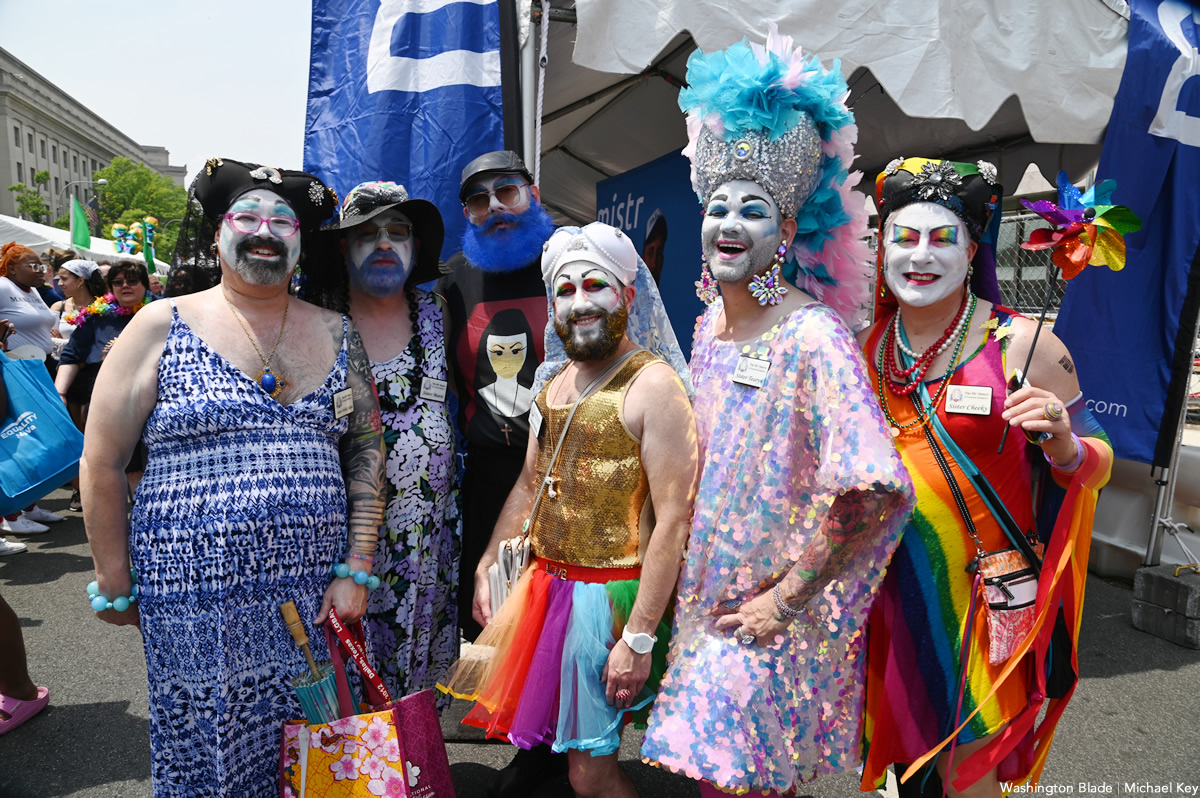
(Editor’s note: Although there has been considerable scholarship focused on LGBTQ community and advocacy in D.C., there is a deficit of scholarship focused on LGBTQ religion in the area. Religion plays an important role in LGBTQ advocacy movements, through queer-affirming ministers and communities, along with queer-phobic churches in the city. This is the final installment of a three-part series exploring the history of religion and LGBTQ advocacy in Washington, D.C. Visit our website for the previous installments.)
Six sisters gathered not so quietly in Marion Park, Washington, D.C. on Saturday, October 8, 2022. As the first sounds of the Women’s March rang out two blocks away at 11 am, the Sisters passed out candles to say Mass on the grass. It was their fifth annual Lavender Mass, but this year’s event in particular told an interesting story of religious reclamation, reimagining a meaningful ritual from an institution that seeks to devalue and oppress queer people.
The D.C. Sisters are a chapter of the Sisters of Perpetual Indulgence, an organization of “drag nuns” ministering to LGBTQ+ and other marginalized communities. What first began as satire on Easter Sunday 1979 when queer men borrowed and wore habits from a production of The Sound of Music became a national organization; the D.C. chapter came about relatively late, receiving approval from the United Nuns Privy Council in April 2016. The D.C. Sisters raise money and contribute to organizations focused on underserved communities in their area, such as Moveable Feast and Trans Lifeline, much like Anglican and Catholic women religious orders.
As Sister Ray Dee O’Active explained, “we tend to say we raise funds, fun, and hell. I love all three. Thousands of dollars for local LGBTQ groups. Pure joy at Pride parades when we greet the next generation of activists. And blatant response to homophobia and transphobia by protest after protest.” The Lavender Mass held on October 8th embodied their response to transphobia both inside and outside pro-choice groups, specifically how the overturn of Roe v. Wade in June 2022 intimately affects members of the LGBTQ+ community.
As a little history about the Mass, Sister Mary Full O’Rage, shown wearing a short red dress and crimson coronet and veil in the photo above developed the Lavender Mass as a “counterpart” or “counter narrative” to the Red Mass, a Catholic Mass held the first Sunday of October in honor Catholics in positions of civil authority, like the Supreme Court Justices. The plan was to celebrate this year’s Lavender Mas on October 1st at the Nuns of the Battlefield Memorial, located right across the street from the Cathedral of St. Matthew the Apostle, where many Supreme Court Justices attend the Red Mass every year.
As Sister Mary explained, this year “it was intended to be a direct protest of the actions of the Supreme Court, in significant measure their overturning of reproductive rights.”
Unfortunately, the October 1st event was canceled due to heavy rain and postponed to October 8th at the recommendation of Sister Ruth Lisque-Hunt and Sister Joy! Totheworld. The focus of the Women’s March this year aligned with the focus of the Lavender Mass—reproductive rights—and this cause, Sister Mary explained, “drove us to plan our Lavender Mass as a true counter-ritual and protest of the Supreme Court of who we expected to attend the Red Mass,” and who were protested in large at the Women’s March.
The “Lavender Mass was something that we could adopt for ourselves,” Sister Mary spoke about past events. The first two Masses took place at the Lutheran Church of the Reformation, right around the corner from the Supreme Court. The second Mass, as Sister Mary explained, celebrated Justice Ruth Bader Ginsburg; “we canonized her.” Canonization of saints in the Catholic Church also takes place during a Mass, a Papal Mass in particular.
During the COVID-19 pandemic, the Sisters moved the Mass outside for safety, and the third and fourth Masses were celebrated at the Nuns of the Battlefield Memorial. “It celebrates nuns, and we are nuns, psycho-clown nuns,” Sister Mary chuckled, “but we are nuns.” After the Mass, the Sisters would gather at a LGBTQ+ safe space or protest at the Catholic Church or Supreme Court. Although they often serve as “sister security” at local events, working to keep queer community members safe according to Sister Amore Fagellare, the Lavender Mass is not widely publicly advertised, out of concern for their own.
On October 8th, nine people gathered on the grass in a circle—six sisters, myself, and two people who were close with professed members—as Sister Mary called us to assemble before leading us all in chanting the chorus to Sister Sledge’s 1979 classic song “We Are Family.”
Next, novice Sister Sybil Liberties set a sacred space, whereby Sister Ruth and Sister Tearyn Upinjustice walked in a circle behind us, unspooling pink and blue ribbons to tie us together as a group. As Sister Sybil explained, “we surround this sacred space in protection and sanctify it with color,” pink for the choice to become a parent and blue for the freedom to choose not to be a parent but also as Sybil elaboration, in recognition of “the broad gender spectrum of people with the ability to become pregnant.” This intentional act was sought to fight transphobia within the fight for reproductive rights.
After singing Lesley Gore’s 1963 song “You Don’t Own Me,” six speakers began the ritual for reproductive rights. Holding out our wax plastic candles, Sister Sybil explained that each speaker would describe a story or reality connected to reproductive rights, and “as I light a series of candles for the different paths we have taken, if you recognize yourself in one of these prayers, I invite you to put your hand over your heart, wherever you are, and know that you are not alone – there is someone else in this gathered community holding their hand over their heart too.”
The Sisters went around the circle lighting a candle for those whose stories include the choice to end a pregnancy; those whose include the unwanted loss of a pregnancy or struggles with fertility; those whose include the choice to give birth, raise or adopt a child; those whose include the choice not to conceive a child, to undergo forced choice, or with no choice at all; those who have encountered violence where there “should have been tenderness and care;” and those whose reproductive stories are still being written today.
After each reading, the group spoke together, “may the beginnings and endings in our stories be held in unconditional love and acceptance,” recalling the Prayer of the Faithful or General Intercessions at Catholic Masswhere congregations respond “Lord, hear our prayer” to each petition. Sister Sybil closed out the ritual as Sister Mary cut the blue and pink ribbons between each person, creating small segments they could take away with them and tie to their garments before walking to the Women’s March. The Sisters gathered their signs, drums, and horns before walking to Folger Park together into the crowd of protestors.
At first glance, the Lavender Mass may appear like religious appropriation, just as the Sisters themselves sometimes look to outsiders. They model themselves after Angelican and Catholic women religious, in dress—they actively refer to their clothing as “habits,” their organization—members must also go through aspirant, postulant, and novice stages to be fully professed and they maintain a hierarchical authority, and in action. Like white and black habits, the Sisters all wear white faces to create a unified image and colorful coronets, varying veil color based on professed stage. Sister Allie Lewya explained at their September 2022 meeting, “something about the veils gives us a lot of authority that is undue,” but as the Sisters reinforced at the Women’s March, they are not cosplayers nor customers, rather committed clergy.
As such, the Sisters see their existence within the liminal spaces between satire, appropriation, and reimagination, instead reclaiming the basis of religious rituals to counter the power holders of this tradition, namely, to counter the Catholic Church and how it celebrates those in positions of authority who restrict reproductive rights. Similarly, the Lavender Mass is modeled after a Catholic or Anglican Mass. It has an intention, namely reproductive rights, a call to assemble, setting of a sacred space, song, chant, and prayer requests. It even uses religious terminology; each section of the Mass is ended with a “may it be/Amen/Awen/Ashay/aho.”
While this ritual—the Lavender Mass—appropriates a religious ritual of the Catholic Church and Anglican Church, this religious appropriation is necessitated by exclusion and queerphobia. As David Ford explains in Queer Psychology, many queer individuals retain a strong connection to their faith communities even though they have experienced trauma from these same communities. Jodi O’Brien builds on this, characterizing Christian religious institutions as spaces of personal meaning making and oppression. This essay further argues that the fact this ritual is adopted and reimagined by a community that the dominant ritual holder—the Catholic Church—oppressed and marginalized, means that it is not religious appropriation at all.
Religious appropriation, as highlighted in Liz Bucar’s recent book, Stealing My Religion (2022), is the acquisition or use of religious traditions, rituals, or objects without a full understanding of the community for which they hold meaning. The Sisters, however, fully understand the implications of calling themselves sisters and the connotations of performing a ritual they call a “Mass” as women religious, a group that do not have this authority in the Catholic Church. It is the reclamation of a tradition that the Sisters of Perpetual Indulgence understand because some were or are part of the Catholic Church.
Some sisters still seek out spiritual meaning, but all also recognize that the Catholic Church itself is an institution that hinders their sisters’ access and actively spreads homophobia and transphobia to this day. As such, through the Lavender Mass, the sisters have reclaimed the Mass as a tool of rebellion in support of queer identity.
Just as the Sisters recognize the meaning and power of the ritual of a Mass, along with the connotations of being a sister, the Lavender Mass fulfilled its purpose as a ritual of intention just as the Sisters fulfill public servants. “As a sister,” Sister Ruth dissected, “as someone who identifies as a drag nun, it perplexes people, but when you get the nitty gritty, we serve a similar purpose, to heal a community, to provide support to a community, to love a community that has not been loved historically in the ways that it should be loved.
The Sisters’ intentionality in recognizing and upholding the role of a woman religious in their work has been well documented as a serious parody for the intention of queer activism by Melissa Wilcox. The Lavender Mass is a form of serious parody, as Wilcox posits in the book: Queer Nuns: Religion, Activism, and Serious Parody(2018). The Mass both challenges the queerphobia of the Catholic Church while also reinforcing the legitimacy of this ritual as a Mass. The Sisters argue that although they would traditionally be excluded from religious leadership in the Catholic Church, they can perform a Mass. In doing so, they challenge the role that women religious play in the Catholic Church as a whole and the power dynamics that exclude queer communities from living authentically within the Church.
By reclaiming a tradition from a religious institution that actively excludes and traumatizes the LGBTQ+ community, the Lavender Mass is a form of religious reclamation in which an oppressed community cultivates queer religious meaning, reclaims a tradition from which they are excluded, and uses it to fuel queer activism (the fight for reproductive rights). This essay argues that the Lavender Mass goes one step further than serious parody. While the Sisters employ serious parody in their religious and activist roles, the Lavender Mass is the active reclamation of a religious tradition for both spiritual and activist ends.
Using the celebration of the Mass as it was intended, just within a different lens for a different purpose, this essay argues, is religious reclamation. As a collection of Austrian and Aotearoan scholars explored most recently in a chapter on acculturation and decolonization, reclamation is associated with the reassertion and ownership of tangibles: of rituals, traditions, objects, and land. The meaning of the Lavender Mass comes not only from the Sisters’ understanding of women religious as a social and religious role but rather from the reclamation of a physical ritual—a Mass—that has specific religious or spiritual meaning for the Sisters.
When asked why it was important to call this ritual a “Mass,” Sister Mary explained: “I think we wanted to have something that denoted a ritual, that was for those who know, that the name signifies that it was a counter-protest. And you know, many of the sisters grew up with faith, not all of them Catholics but some, so I think ‘Mass’ was a name that resonated for many of us.”
As Sister Ray said, “my faith as a queer person tends to ostracize me but the Sisters bring the imagery and language of faith right into the middle of the LGBTQ world.” This Lavender Mass, although only attended and experienced by a few of the Women’s March protests, lived up to its goal as “a form of protest that is hopefully very loud,” as Sister Millie Taint advertised in the Sisters’ September 2022 chapter meeting. It brought religious imagery and language of faith to a march for reproductive rights, using a recognized model of ritual to empower protestors.
The Lavender Mass this year, as always, was an act of rebellion, but by situating itself before the Women’s March and focusing its intention for reproductive rights, the Sisters’ reclaimed a religious ritual from a system of authority which actively oppressed LGBTQ+ peoples and those with the ability to become pregnant, namely the Catholic Church, and for harnessing it for personal, political, and spiritual power. In essence, it modelled a system of religious reclamation, by which a marginalized community takes up a religious ritual to make its own meaning and oppose the religious institution that seeks to exclude the community from ritual participation.
Emma Cieslik will be presenting on LGBTQ+ Religion in the Capital at the DC History Conference on Friday, April 6th. She is working with a DC History Fellow to establish a roundtable committed to recording and preserving this vital history. If you have any information about these histories, please reach out to Emma Cieslik at [email protected] or the Rainbow History Project at [email protected].
-

 South America4 days ago
South America4 days agoDaniel Zamudio murderer’s parole request denied
-

 Maryland5 days ago
Maryland5 days agoMontgomery County police chief discusses arrest of trans student charged with planned school shooting
-

 State Department22 hours ago
State Department22 hours agoState Department releases annual human rights report
-

 Theater4 days ago
Theater4 days ago‘Amm(i)gone’ explores family, queerness, and faith

